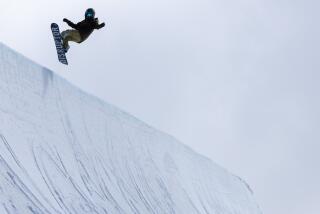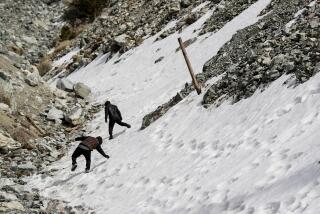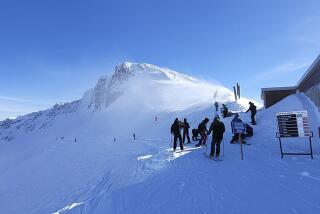Cold comfort in a busy ER
- Share via
Truckee, Calif. — As the nurse peels back bloody gauze on the leg sliced by a loose ski, radiologists down the hall at Tahoe Forest Hospital are confirming their fourth fracture on a Saturday that will see 53.
A few miles away, a blond 6-year-old scrambles atop an inner tube. When the tube won’t go, she rocks it, urging speed. At last, trees blur by and she’s out of control. The tube careens to the right and the girl tumbles off, immediately starting to cry. The fall looks benign, but when her father rushes over she says her back hurts. He calls 911.
Meanwhile, over at the Homewood ski area, Johnny Cruse exits the chairlift for his third run of the day and pushes off on his poles down the mountain. The sky is gray, the light dull, and he doesn’t notice the catwalk that cuts a flat path across the fall line. Cruse flies over the lip, launches into pure air and, thwack, lands on his neck and back. His head smacks the hardpack, jamming his helmet into his goggles. Broken plexiglass plows over his nose, scraping away a layer of flesh.
A bull of a man, Cruse bounces and struggles to regain his feet but instead flips, and then he is sliding, unable to see the world jarring past. His feet, encased in skiless boots, stab the snow and are flung over his head. He feels like a piece of paper snapping violently in a fierce wind.
A buddy skiing behind Cruse finds him lying on his side. “He was pretty afraid that I had broken my back,” Cruse says. “He said, ‘Johnny, Johnny,’ and I finally answered him.”
Ambulances carrying the little girl and Cruse reach the Tahoe Forest emergency room within minutes of each other. Both victims grunt as they are lifted onto gurneys.
The little girl is crying.
“Sledding accidents are the worst,” confides Nancy Amundson, a nurse here at the only major health center serving Truckee, Calif., and the surrounding 16 ski areas. Two years ago, she recalls, a man in his 70s came in. His wife had asked him not to go sledding, certain he would injure himself. She followed him to the hill and stood at the bottom, pleading as she watched him climb. He started down, lost control and struck her. She died shortly after he carried her into the ER.
A doctor and nurses crowd around the panicked little girl and her parents.
Two beds away, Cruse, a vacationer from San Diego, smiles and tells a physician what happened. “If you docs are really good, I’ll be skiing tomorrow,” he says.
The physician laughs and glances at the little girl.
*
Fractured honor roll
Michael Brown and his wife, Jill, calmly watch Russ Mann, R.N., cut away gauze to reveal a deep cut about the size of a 3-by-5 card. The flesh, sliced by the edge of Brown’s ski when it popped off his boot at Alpine Meadows, oozes red, and the calf muscle shines through like a purple water balloon.
“Oh, this isn’t bad,” Mann says warmly. “We’re just going to numb this and stitch it right up.” He casually reaches for a syringe of Novocain.
When Brown’s eyes hit the metal shaft of the needle, they roll back. His face flushes red, and he lets out a sharp yelp. He throws back his head and grasps Jill’s hands.
“He really doesn’t like needles,” she explains.
As Mann cleans the wound in preparation for more than 40 stitches, a patient diagnosed with schizophrenia bolts from an exam room, knocking over a cup of coffee as he bursts through large doors leading outside. A police officer chases him. The nurses behind the large desk talk quietly while maneuvering files. By the time the officer returns with the patient in handcuffs, the coffee has been mopped up.
“This job is a lot of fun,” Mann says cheerily, walking to the waiting room to greet his next patient.
A medical staff ranging from six to nine will see 87 patients, almost all with injuries from the surrounding slopes, on this Saturday in late January. Only the affected body parts -- more wrist fractures with the rise in snowboarding, fewer foot injuries as boots improve -- distinguish 2004 from decades past. A banner titled “Wrist Fracture Hall of Fame” goes up in the hallway before the snow flies. By mid-January it is crowded with awkward signatures, the first attempts at writing in freshly cast hands. Last year’s autograph count: 1,000, including 32 in one day.
Staff turnover is low and spirits run high in the ER. “I live in Reno, and I would drive here to get treatment,” says nurse Teri Johnstone. She looks at a colleague. “Unless I had something I didn’t want anyone else to know about.”
The nurses have developed methods for dealing with the stress of treating trauma. But the worst cases will always stick with them. Late at night around the desk, they describe the most shocking: the kid with a tree limb up his rectum; the woman hit by a snowplow; the man, just yesterday, who stapled his jeans and belt to his pelvis with a poorly placed nail gun.
“We can help people almost right away, though,” says Amundson. “It’s not like other hospitals where everyone is sick. We get instant gratification.”
For every 1,000 skiers or snowboarders using a mountain on an average day, 11.3 will suffer injuries that require medical treatment, according to the Consumer Product Safety Commission. Ski patrol volunteers, who first encounter the injured on mountains, report more difficulty than ER staff in coping with stress.
The first season Lel Tone, 33, patrolled, she was just 19 years old. A skier a year younger than she stood on a hill in a blind spot, she recalls, watching a friend approach a jump. A third skier struck him. The impact broke eight ribs, punctured a lung and slammed his head against a tree. Collisions, Tone says, cause the worst injuries. After she performed CPR, he died. “I thought I was fine, but that night I started throwing up everywhere,” she says. “My body was telling me I wasn’t OK.”
*
The X-ray verdict
The little blond girl is still crying -- screaming now, really -- as her parents wait for the X-rays to return. Cruse also waits to hear the extent of the damage, and the morphine is starting to ebb. His cellphone keeps ringing, but he ignores it.
A technician hands a portfolio of dark film to the physician standing alongside the little girl, and he mounts them in a light box. Her wails quiet slightly, and everyone looks anxiously from the illuminated spinal cord to the doctor and back again.
“She’s going to be fine,” the doctor says. “I think she just bruised herself.”
Cruse receives his prognosis too: bilateral femur fractures. Both legs are broken. After surgery that night, he will have to use a wheelchair for four weeks. It will take six to nine months before he regains his full abilities. Cruse sighs disappointedly and gazes at a wall of fresh crutches hanging beside him. “Got to stay positive,” he says calmly.
His cell rings again, flashing his wife’s number. He answers, gives her the news, listens and then hangs up.
“She said, ‘I think I’ll kill you when you get home,’ ” he says, smiling. “She’s pretty upset with me.” He looks at the nurse. “So how long until I can ski again?” he asks.
*
One day’s toll
On a Saturday in January, the emergency room staff at Tahoe Forest Hospital, which receives the bulk of the emergencies from 16 nearby ski areas, treated only nine broken wrists. The record for one day: 32. Backs, shoulders and legs, including knees and ankles, also took a beating on the slopes that day with a total of 25 injuries.
-- Charles Duhigg
*
Charles Duhigg is a Times staff writer. He can be reached at [email protected].
More to Read
Sign up for Essential California
The most important California stories and recommendations in your inbox every morning.
You may occasionally receive promotional content from the Los Angeles Times.










